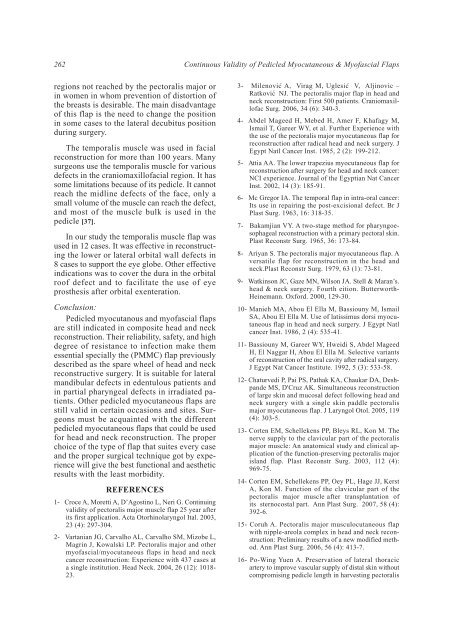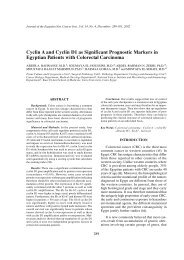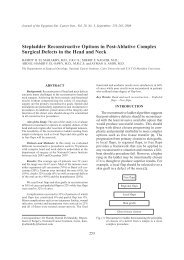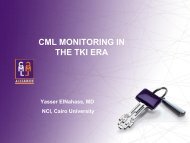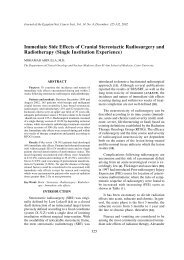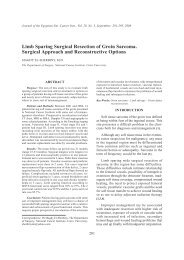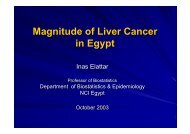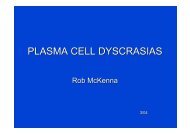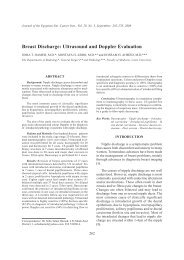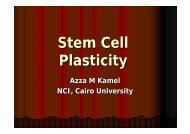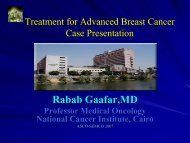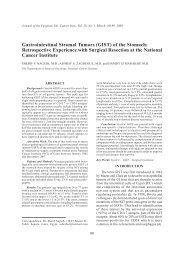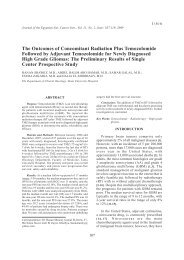Continuous Validity of Pedicled Myocutaneous and Myofascial ... - NCI
Continuous Validity of Pedicled Myocutaneous and Myofascial ... - NCI
Continuous Validity of Pedicled Myocutaneous and Myofascial ... - NCI
Create successful ePaper yourself
Turn your PDF publications into a flip-book with our unique Google optimized e-Paper software.
262<br />
<strong>Continuous</strong> <strong>Validity</strong> <strong>of</strong> <strong>Pedicled</strong> <strong>Myocutaneous</strong> & My<strong>of</strong>ascial Flaps<br />
regions not reached by the pectoralis major or<br />
in women in whom prevention <strong>of</strong> distortion <strong>of</strong><br />
the breasts is desirable. The main disadvantage<br />
<strong>of</strong> this flap is the need to change the position<br />
in some cases to the lateral decubitus position<br />
during surgery.<br />
The temporalis muscle was used in facial<br />
reconstruction for more than 100 years. Many<br />
surgeons use the temporalis muscle for various<br />
defects in the craniomaxill<strong>of</strong>acial region. It has<br />
some limitations because <strong>of</strong> its pedicle. It cannot<br />
reach the midline defects <strong>of</strong> the face, only a<br />
small volume <strong>of</strong> the muscle can reach the defect,<br />
<strong>and</strong> most <strong>of</strong> the muscle bulk is used in the<br />
pedicle [37].<br />
In our study the temporalis muscle flap was<br />
used in 12 cases. It was effective in reconstructing<br />
the lower or lateral orbital wall defects in<br />
8 cases to support the eye globe. Other effective<br />
indications was to cover the dura in the orbital<br />
ro<strong>of</strong> defect <strong>and</strong> to facilitate the use <strong>of</strong> eye<br />
prosthesis after orbital exenteration.<br />
Conclusion:<br />
<strong>Pedicled</strong> myocutanous <strong>and</strong> my<strong>of</strong>ascial flaps<br />
are still indicated in composite head <strong>and</strong> neck<br />
reconstruction. Their reliability, safety, <strong>and</strong> high<br />
degree <strong>of</strong> resistance to infection make them<br />
essential specially the (PMMC) flap previously<br />
described as the spare wheel <strong>of</strong> head <strong>and</strong> neck<br />
reconstructive surgery. It is suitable for lateral<br />
m<strong>and</strong>ibular defects in edentulous patients <strong>and</strong><br />
in partial pharyngeal defects in irradiated patients.<br />
Other pedicled myocutaneous flaps are<br />
still valid in certain occasions <strong>and</strong> sites. Surgeons<br />
must be acquainted with the different<br />
pedicled myocutaneous flaps that could be used<br />
for head <strong>and</strong> neck reconstruction. The proper<br />
choice <strong>of</strong> the type <strong>of</strong> flap that suites every case<br />
<strong>and</strong> the proper surgical technique got by experience<br />
will give the best functional <strong>and</strong> aesthetic<br />
results with the least morbidity.<br />
REFERENCES<br />
1- Croce A, Moretti A, D’Agostino L, Neri G. Continuing<br />
validity <strong>of</strong> pectoralis major muscle flap 25 year after<br />
its first application. Acta Otorhinolaryngol Ital. 2003,<br />
23 (4): 297-304.<br />
2- Vartanian JG, Carvalho AL, Carvalho SM, Mizobe L,<br />
Magrin J, Kowalski LP. Pectoralis major <strong>and</strong> other<br />
my<strong>of</strong>ascial/myocutaneous flaps in head <strong>and</strong> neck<br />
cancer reconstruction: Experience with 437 cases at<br />
a single institution. Head Neck. 2004, 26 (12): 1018-<br />
23.<br />
3- Milenovic ´ A, Virag M, Uglesic ´ V, Aljinovic –<br />
Ratkovic ´ NJ. The pectoralis major flap in head <strong>and</strong><br />
neck reconstruction: First 500 patients. Craniomaxill<strong>of</strong>ac<br />
Surg. 2006, 34 (6): 340-3.<br />
4- Abdel Mageed H, Mebed H, Amer F, Khafagy M,<br />
Ismail T, Gareer WY, et al. Further Experience with<br />
the use <strong>of</strong> the pectoralis major myocutaneous flap for<br />
reconstruction after radical head <strong>and</strong> neck surgery. J<br />
Egypt Natl Cancer Inst. 1985, 2 (2): 199-212.<br />
5- Attia AA. The lower trapezius myocutaneous flap for<br />
reconstruction after surgery for head <strong>and</strong> neck cancer:<br />
<strong>NCI</strong> experience. Journal <strong>of</strong> the Egyptian Nat Cancer<br />
Inst. 2002, 14 (3): 185-91.<br />
6- Mc Gregor IA. The temporal flap in intra-oral cancer:<br />
Its use in repairing the post-excisional defect. Br J<br />
Plast Surg. 1963, 16: 318-35.<br />
7- Bakamjian VY. A two-stage method for pharyngoesophageal<br />
reconstruction with a primary pectoral skin.<br />
Plast Reconstr Surg. 1965, 36: 173-84.<br />
8- Ariyan S. The pectoralis major myocutaneous flap. A<br />
versatile flap for reconstruction in the head <strong>and</strong><br />
neck.Plast Reconstr Surg. 1979, 63 (1): 73-81.<br />
9- Watkinson JC, Gaze MN, Wilson JA. Stell & Maran’s.<br />
head & neck surgery. Fourth eition. Butterworth-<br />
Heinemann. Oxford. 2000, 129-30.<br />
10- Manieh MA, Abou El Ella M, Bassiouny M, Ismail<br />
SA, Abou El Ella M. Use <strong>of</strong> latissimus dorsi myocutaneous<br />
flap in head <strong>and</strong> neck surgery. J Egypt Natl<br />
cancer Inst. 1986, 2 (4): 535-41.<br />
11- Bassiouny M, Gareer WY, Hweidi S, Abdel Mageed<br />
H, El Naggar H, Abou El Ella M. Selective variants<br />
<strong>of</strong> reconstruction <strong>of</strong> the oral cavity after radical surgery.<br />
J Egypt Nat Cancer Institute. 1992, 5 (3): 533-58.<br />
12- Chaturvedi P, Pai PS, Pathak KA, Chaukar DA, Deshp<strong>and</strong>e<br />
MS, D'Cruz AK. Simultaneous reconstruction<br />
<strong>of</strong> large skin <strong>and</strong> mucosal defect following head <strong>and</strong><br />
neck surgery with a single skin paddle pectoralis<br />
major myocutaneous flap. J Laryngol Otol. 2005, 119<br />
(4): 303-5.<br />
13- Corten EM, Schellekens PP, Bleys RL, Kon M. The<br />
nerve supply to the clavicular part <strong>of</strong> the pectoralis<br />
major muscle: An anatomical study <strong>and</strong> clinical application<br />
<strong>of</strong> the function-preserving pectoralis major<br />
isl<strong>and</strong> flap. Plast Reconstr Surg. 2003, 112 (4):<br />
969-75.<br />
14- Corten EM, Schellekens PP, Oey PL, Hage JJ, Kerst<br />
A, Kon M. Function <strong>of</strong> the clavicular part <strong>of</strong> the<br />
pectoralis major muscle after transplantation <strong>of</strong><br />
its sternocostal part. Ann Plast Surg. 2007, 58 (4):<br />
392-6.<br />
15- Coruh A. Pectoralis major musculocutaneous flap<br />
with nipple-areola complex in head <strong>and</strong> neck reconstruction:<br />
Preliminary results <strong>of</strong> a new modified method.<br />
Ann Plast Surg. 2006, 56 (4): 413-7.<br />
16- Po-Wing Yuen A. Preservation <strong>of</strong> lateral thoracic<br />
artery to improve vascular supply <strong>of</strong> distal skin without<br />
compromising pedicle length in harvesting pectoralis


